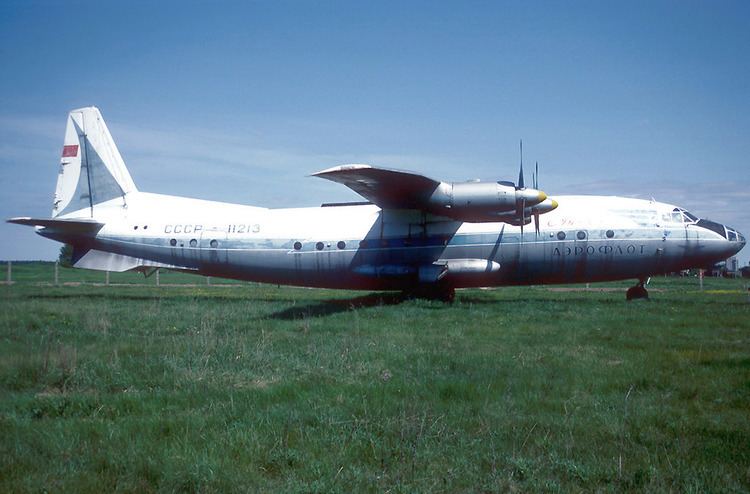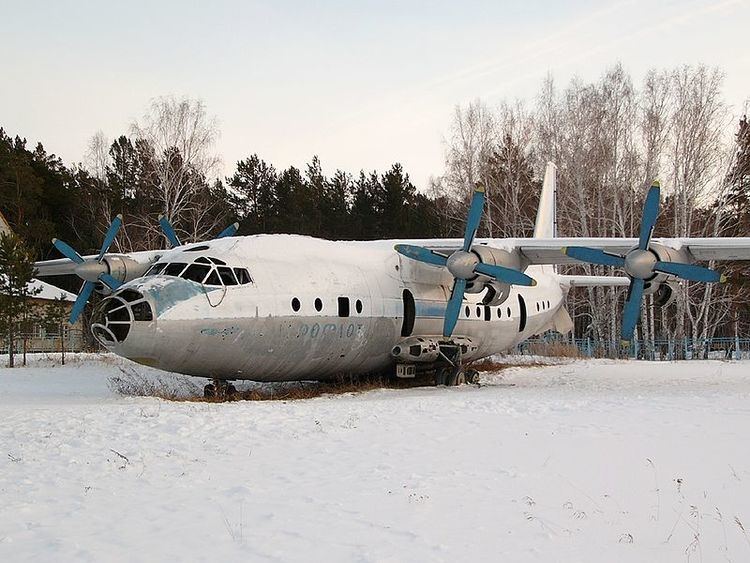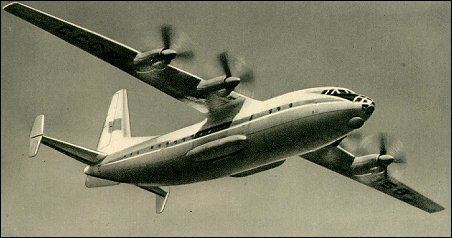Top speed 725 km/h Length 37 m Weight 30,500 kg | Range 4,074 km Wingspan 38 m Cruise speed 660 km/h | |
 | ||
Antonov an 10 ukraine nato code cat
The Antonov An-10 (NATO reporting name: Cat) was a four-engined turboprop passenger transport aircraft designed in the Soviet Union.
Contents
- Antonov an 10 ukraine nato code cat
- Design and development
- Operational history
- Operators
- Variants
- Accidents and incidents
- Specifications An 10A
- References

Design and development

Development of a four-engined airliner intended for use on routes from 500 to 2000 kilometers (310 to 1,262 miles) began at the end of 1955. Inspired by the Izdeliye N (Izdeliye – article or product) passenger version of the Antonov An-8 the Antonov design bureau developed the Izdeliye U ("U" for "Universal"), a four-engined aircraft with similar layout to the An-8, but with increased dimensions and a circular section pressurised fuselage. Early in the design process the choice of engines was between the Kuznetsov NK-4 and Ivchenko AI-20 and despite superior performance the Kuznetsov NK-4 was eliminated and the Ivchenko AI-20 selected partly due to the Central Committee of the Communist Party of Ukraine which wanted as much as possible produced in Ukraine, where the Ivchenko factory was.
The first prototype flew on 7 March 1957, revealing poor directional stability which led to a taller vertical fin, and later to hexagonal auxiliary fins at the tips of the tailplane. Entering production at Zavod (factory) No.64, Voronezh in 1957 the initial three aircraft were delivered with Kuznetsov NK-4 engines due to the non-availability of the Ivchenko AI-20 engines. From 1958, production aircraft were delivered with the Ivchenko AI-20A engines which boasted a longer service life and comparable performance compared to the Kuznetsov engines. The new aircraft was displayed to the public for the first time in July 1957; the design was approved for mass production after testing was completed in June 1959. Aeroflot began operations with the An-10 from 22 July 1959 on the Moscow – Simferopol route.

Configured with 85 seats, the cabin was spacious and well-appointed with comfortable seats widely spaced giving plenty of legroom, but due to the low cabin floor and wide diameter there was a lot of unusable space which limited baggage and cargo volumes. The inefficient use of cabin volume contributed greatly to the low payload/TOW ratio which was much lower than the contemporary Ilyushin Il-18, but which was still higher than the Tupolev Tu-104. A later production version, the An-10A, addressed some of the efficiency concerns by increasing the number of seats from 85 to 89 and 100 (in the two versions of the An-10A), then to 117–118 and finally 132 through reducing seat pitch and changing the cabin layout. Powered by Ivchenko AI-20K engines the An-10A demonstrated superior performance and an increased maximum payload of 14.5 Tonnes (31,970 lb). The auxiliary end-plate fins eventually gave way to improved splayed ventral fins under the rear fuselage. The directional stability was now acceptable and the new ventral fins also improved longitudinal stability at high g and on landing approach, as well as delaying the onset of Mach buffet to M0.702. Due to being sited in an area of flow separation, the new ventral fins also caused unpleasant vibrations. Following results of flight tests and at least two fatal crashes an effective tailplane de-icing system was retro-fitted to all remaining aircraft.
Operational history

A total of 104 aircraft were built, including the prototype and static test airframes, entering service with the Ukrainian Civil Aviation Directorate of Aeroflot from 27 April 1959, proving popular due to large cargo volume (when fitted with reduced seating) and excellent field performance making the aircraft suitable for use on small undeveloped airfields. The Antonov Bureau simultaneously developed and produced the Antonov An-8 medium military transport, An-10 civil airliner and military paratroop transport, as well as the Antonov An-12 military cargo transport.

On 22 April 1962 an An-10A piloted by A. Mitronin gained a world record 500 km closed loop speed record averaging 730.6 kilometres per hour (454.0 mph).
The performance of the An-10 and An-10A was relatively good and was shown to have lower seat/mile costs than the contemporary Tupolev Tu-104 jet airliner but continued to exhibit control and stability problems, culminating in a fatal crash on 16 November 1959 when CCCP-11167 dived into the ground while on approach to L'vov airport, due to reduced stability, abrupt nose drops at low airspeeds and reduced elevator authority at low airspeeds. On 26 February 1960, again at L'vov, CCCP-11180 crashed at the same location due to reduced longitudinal stability and control authority caused by icing of the tailplane.
Military use of the An-10 was fairly extensive with 45 An-10TS built for the VTA, 16 flown exclusively by military units and the remaining 38 loaned to the Ministry of Civil Aviation, as well as the flyable aircraft remaining after withdrawal from Aeroflot service.
On 18 May 1972, while descending to Kharkiv International Airport an An-10 crashed, killing 8 crew and 113 passengers. An investigation revealed fatigue cracking of the wing centre-section stringers on many of the remaining aircraft. Following this accident, Aeroflot ceased operating the An-10.
After withdrawal from Aeroflot service on 27 August 1972, 25 An-10A aircraft which were in good condition were transferred to the VVS (Soviet Air Force) and other MAP (Ministry of Aircraft Production) units. These remaining An-10As were retired by 1974.
A few examples have been preserved as exhibits in museums, and several have been converted into children's theatres (at Kiev, Samara and Novocherkassk).
Operators
Variants
Accidents and incidents
Over its life, the An-10 experienced 12 accidents, with 370 fatalities. The An-10 carried more than 35 million passengers and 1.2 million tons of cargo, and its competitor, the Il-18 suffered from 51 fatal accidents with 1359 fatalities over the same period.
Specifications (An-10A)
Data from Soviet Transport Aircraft since 1945
General characteristics
Performance
